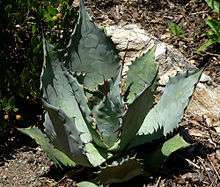Agave shrevei
Agave shrevei is a member of the family Asparagaceae, indigenous to the Sierra Madre Occidental in Mexico, along the boundary between the states of Chihuahua and Sonora.[1][2][3] Two subspecies are currently recognized, although a third has been proposed (A. shrevei subsp. magna H.S. Gentry).[4]
| Agave shrevei | |
|---|---|
 | |
| Agave shrevei subsp. shrevei | |
| Scientific classification | |
| Kingdom: | Plantae |
| Clade: | Tracheophytes |
| Clade: | Angiosperms |
| Clade: | Monocots |
| Order: | Asparagales |
| Family: | Asparagaceae |
| Subfamily: | Agavoideae |
| Genus: | Agave |
| Species: | A. shrevei |
| Binomial name | |
| Agave shrevei | |
| Subspecies | |
Description
Agave shrevei subsp. matapensis grows as an open basal rosette of 0.7-0.8 inch long, 0.2-0.3 inch wide leaves bearing distinct compaction marks, fringed in small pale spines and tipped with particularly long apical needles with bases of up to 0.4 inches wide. Has small pale yellow flowers.
Cultivation
Propagates mainly by seed and grows quite slowly compared to larger agaves.
Uses
Some of the indigenous peoples of the region consume the plant as a food source. The immature flowering stalks are sweet and juicy and easy to harvest. People either eat them raw or brew them into alcoholic beverages. The leaf bases are also edible, but require roasting to destroy unpleasant chemical compounds [5][6]
References
- Gentry, H. S. 1982. Agaves of continental North America. University of Arizona Press, Tucson.
- H.S. Gentry, Publications of the Carnegie Institute of Washington 527:95. 1942
- The Complete Encyclopedia of Succulents by Zdenek Jezek and Libor Kunte
- Gentry H.S. 1971. The Agave family in Sonora. USDA Agricultural Handbook 399.
- Laferriere, Joseph E. 1991. Optimal use of ethnobotanical resources by the Mountain Pima of Chihuahua, Mexico. PhD dissertation, University of Arizona
- Laferrière, Joseph E., Charles W. Weber and Edwin A. Kohlhepp. 1991a. Use and nutritional composition of some traditional Mountain Pima plant foods. Journal of Ethnobiology 11(1):93-114.